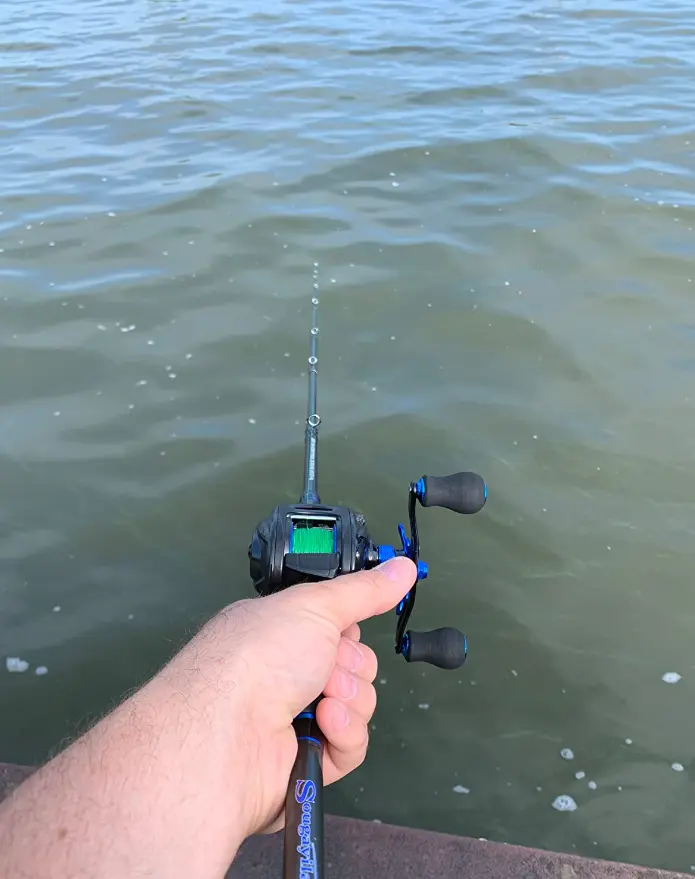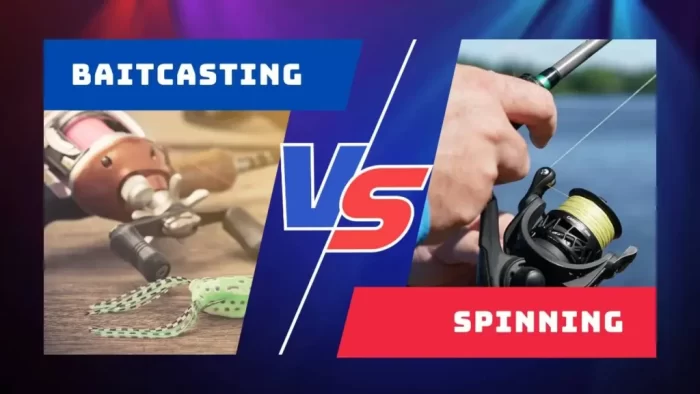Baitcasting vs Spinning Reel – it’s a debate that has been waged for years and continues to be one of the biggest debates among anglers.
Baitcasting reels provide greater accuracy, longer casting distance, and more control when fishing, while spinning reels are lighter, easier to use, and require less maintenance. So which is better? Next time you go fishing, which reel should you choose?
You’ll learn which baitcasting or spinning reel is best for you by comparing them head-to-head in this article. Throughout the article, we’ll discuss what makes each type of reel special, as well as its strengths and weaknesses.
With this information, you’ll be able to make an educated decision on which one is right for your next fishing adventure. Let’s explore this further.
What Is A Spinning Reel?

A spinning reel is a type of fishing reel most commonly used for freshwater and light saltwater fishing. This type of reel is also known as an open-faced reel or a fixed-spool reel. Spinning reels are relatively easy to use, making them great for beginners who are just starting out in the sport of fishing.
The spinning reel works by anglers casting their line out with the rod and then using a bail arm to retrieve it.
The Bail Arm is a metal piece on the spinning reel that flips over when the line is cast and then pulls in the line as it’s retrieved. The Bail Arm also helps keep the line from tangling or getting caught on other objects.
Spinning reels are generally used for light tackle game fishing, such as catching bass or trout, as well as trolling and jigging in deeper waters. They’re also great for surf casting in the ocean. An angler can target their preferred species with a variety of baits, lures, and techniques when spinning reel fishing.
Now that you know a bit about spinning reels, let’s move on to baitcasting reels and see how they compare.
Read About: Is Baitcaster Good for Trout? Pro Anglers Explained
What Is A Baitcasting Reel?

In fishing, a baitcasting reel is typically used for heavier line and larger game fish. An angler who uses a baitcasting reel will benefit from greater accuracy, longer casting distances, and a greater control.
There is a spool that is mounted above the rod on baitcasting reels. This allows the angler to cast with greater accuracy as the spool is located close to the rod.
Baitcasting reels also allow for more control when fishing, as the angler can make adjustments to line tension and spool speed during retrieval.
Fishing with baitcasting reels is great for catching larger game fish, such as bass and salmon. They’re also great for deep-sea trolling and jigging, as baitcasting reels can handle heavier lines and larger baits. Baitcasting reels require more skill to use, so experienced anglers usually prefer them.
Now that you know the difference between a Baitcasting reel and a spinning reel, let’s look at their respective strengths and weaknesses.
Read Our Reviews: Top 8 Best Budget Baitcaster Combo 2023
Baitcasting Reel Vs Spinning Reel: The Differences

- Baitcasting reels are more suitable for experienced anglers while spinning reels are better suited for beginners.
- Bait cast reels offer more accurate casting and better control over casting distance while spinning reels are less likely to tangle or bird nest.
- Baitcasting reels are better suited for heavy lures and large fish while spinning reels are more versatile for different types of fishing.
- Baitcasting reels can handle larger fishing lines while spinning reels are generally more affordable and easier to master.
- Baitcasting reels are generally more suitable for freshwater fishing, targeting big fish and bass fishing, while spinning reels are good for general-purpose fishing, and can be used in freshwater and saltwater.
- Baitcasting reels are more suitable for casting in windy conditions while spinning reels are better for casting in calm conditions.
- Baitcast reels typically have a higher gear ratio, which allows for faster retrieve speeds. Spinning reels, on the other hand, have a slower gear ratio, which is better for fighting strong fish.
- Casting reels have a more complex design with multiple moving parts, which can make them more prone to malfunction or breakage. Traditional reels have a simpler design and are generally more durable.
- Baitcasting reels are more suited for heavy cover fishing or heavy structure fishing while spinning reels are better for open-water fishing.
- Baitcasting reels require more skill and practice to master while spinning reels are easier to learn and use.
- Baitcaster reels have a more sensitive drag system, which allows for better control over fighting fish. Spinning reels have a less sensitive drag system, which can make it harder to control the fish.
- Baitcasting reels are more suitable for casting heavy lures or baits while spinning reels are better for casting light lures or baits.
- Baitcasting reels can handle larger fishing lines while spinning reels are better suited for smaller fishing lines.
- Casting reels are more suitable for flipping, pitching, and casting, while spinning reels are better for trolling, jigging, and casting.
Baitcasting Reels Pros and Cons:
As with any type of reel, Baitcasting reels have their own set of pros and cons.
Pros:
- Greater accuracy when casting
- More control over line tension and spool speed during retrieval
- Allows for heavier line and larger game fish
- Better suited for flipping, pitching, and casting
Cons:
- Takes more skill to use it effectively
- More complex design with multiple moving parts, making it more prone to malfunction or breakage
- Can be harder to cast in windy conditions
Spinning Reel Pros and Cons:
Just like Baitcasting reels, spinning reels also have their own set of pros and cons.
Pros:
- Easier to learn and use
- Less likely to tangle or bird nest
- More affordable and versatile for different types of fishing
- Better suited for trolling, jigging, and casting in calm conditions
Cons:
- Not as accurate when casting compared to Baitcasting reels
- Less powerful drag system for fighting large fish
- Not as well suited for heavy cover fishing or throwing heavier lures and baits
Which one is best either baitcasting or spinning reel?

“The best” in this case does not have to be an absolute qualification – the best reel for you depends entirely on your skill level and the type of fishing you plan to do.
Both baitcasting and spinning reels have their own unique advantages and disadvantages, and which one is best for you will depend on your personal preference and the type of fishing you will be doing.
Baitcasting reels are generally considered more accurate and better for catching larger fish, as they allow for more control over the bait and the line. They also allow for more power in the cast and can handle heavier fishing lines. However, they can be more difficult to learn to use and may be more prone to tangling.
Spinning reels, on the other hand, are generally considered to be easier to use and better for beginners. Additionally, these are less likely to tangle and provide a smoother, more consistent cast.
They are also versatile, they can be used in freshwater or saltwater fishing and are also useful for casting light lures or baits. However, they do not provide as much control over the bait and line as a baitcasting reel, and may not be as suitable for catching larger fish.
In summary, baitcasting reels are best for experienced anglers who are targeting larger fish and want more control over the bait and line, while spinning reels are better for beginners and those who want a more user-friendly option.
Casting a Baitcaster Reel vs Casting a Spin Reel
Casting Baitcasting Reels:

Baitcasting reels require more skill and patience to be able to cast properly, as it takes some practice to get used to the reel’s spool speed and tension settings. To cast a baitcaster, anglers should start by positioning their thumb on the spool for control, then use a slow and steady motion to pull the line out of the reel.
This will allow for more accuracy when casting, as it helps to reduce backlash from the spool. Once the desired length is reached, releasing pressure on the spool will result in a smooth and consistent cast.
Casting Spinning Reels:

In comparison, spinning reels are much easier to cast. All that’s required is a simple flick of the wrist and release of pressure on the spool, which results in a smooth arc of the line being released from the reel. Spinning reels also allow for longer distances when casting, making them ideal for those looking to cover large areas of water.
Which Is Easier To Cast Baitcasting Or Spinning Reels?
Ultimately, it depends on the angler’s experience and preference. Baitcasting reels may require more patience to learn how to cast them, but for those with some practice, they can be very accurate and powerful when used correctly.
As for spinning reels, they are extremely easy to cast, so they are perfect for beginners. The ultimate decision will depend on your personal preferences and the type of fishing you intend to do.
Frequently Asked Questions (Faqs)
Is a baitcaster better than a spinning reel?
Your own individual preferences and the type of fishing you intend to do determine the answer to this question. Baitcasting reels are generally more accurate, powerful, and better for catching bigger fish while spinning reels are easier to use, less prone to tangling, and may be more suitable for beginners. Whatever is right for you is ultimately up to you.
Why do pros use baitcasters?
Pros use Baitcasting reels because they offer more accuracy, control, and power when casting. Baitcasting reels also provide more precision when setting the hook, making them perfect for targeting larger fish.
They are also generally more durable than spinning reels and able to handle heavier fishing lines. All of these features make Baitcasters the preferred choice of experienced anglers.
Why are baitcasters so hard to use?
The spool speed and tension settings on baitcasting reels need to be adjusted for an accurate cast, making them more difficult to use than spinning reels. The proper thumbing of the spool and controlling backlash from the reel also require practice. With some patience and practice, however, Baitcasters can be mastered and become a very useful tool for experienced anglers.
Conclusion
Both baitcasting and spinning reels are great options for fishing, but the right one really depends on the individual’s preference and skill level. Ultimately, no option necessarily is better than the other one to purchase—it’s all a matter of personal choices.
With slightly different objectives in mind, both types offer distinct advantages and disadvantages each angler can explore to determine what works best for them.
With this guide today, we hope you have found informative information to help you properly choose which reel is best for you! Now all that’s left is taking your knowledge out onto the high seas… So, What has been your favorite reel for fishing thus far? Let us know in the comments below!


